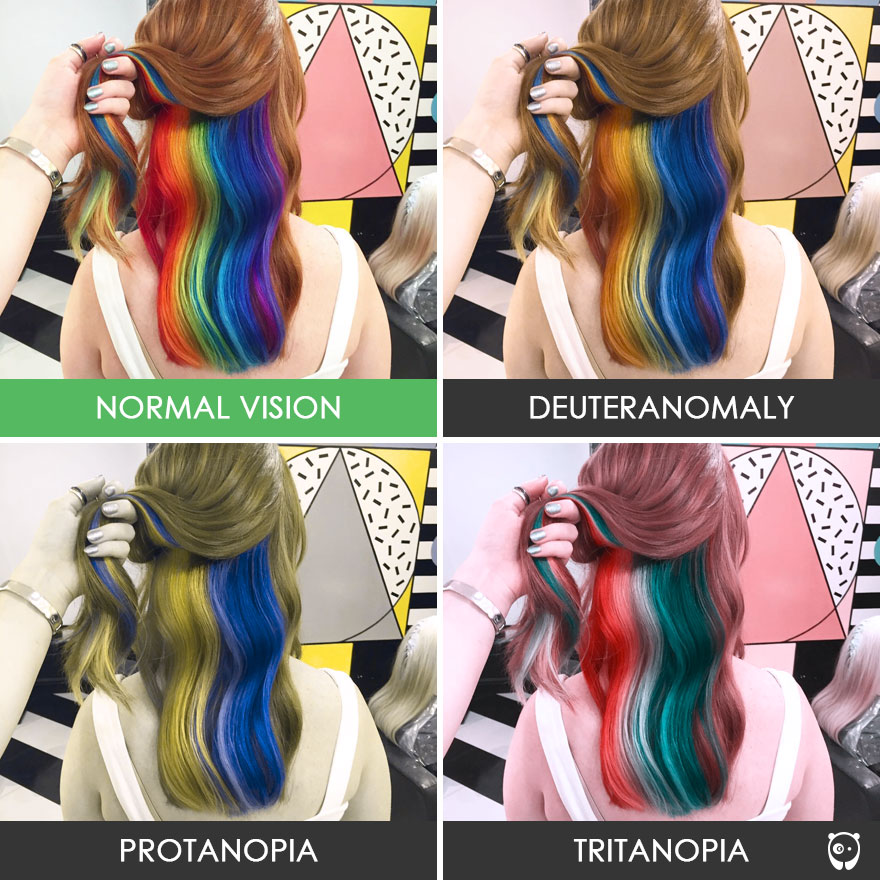Imagine a world where the vibrant hues of a sunset appear muted, where the ripe redness of a strawberry blends with the green of surrounding leaves, and where the shades of clothing you wear are difficult to distinguish. This is the reality for many individuals living with color blindness, a condition that affects how they perceive colors.

Image: ma3loma.com
While the term “color blind” might evoke images of a world completely devoid of color, the reality is far more nuanced. Different types of color blindness exist, each impacting an individual’s color vision in unique ways. This article delves into the world of color blindness, exploring the various forms it takes, what it’s like to experience it, and the fascinating mechanisms behind this intriguing condition.
Understanding Color Blindness: A Journey into the Eye
Before we embark on a exploration of color vision, it’s crucial to understand the basic mechanics of how humans perceive color. When light enters the eye, it lands on the retina, a light-sensitive layer at the back of the eye. Within the retina are specialized cells known as photoreceptor cells, responsible for converting light signals into electrical impulses that our brain interprets as color.
There are two primary types of photoreceptor cells: rods and cones. Rods primarily detect light and darkness, while cones come in three varieties, each sensitive to different wavelengths of light. These cones are responsible for our ability to perceive colors. One type of cone is sensitive to red light, another to green light, and the third to blue light.
Color blindness, also known as color vision deficiency, occurs when one or more of these cone types are missing or malfunctioning. This prevents the brain from receiving the complete spectrum of color information, resulting in a distorted view of the world.
The Spectrum of Color Blindness: A Multitude of Experiences
Color blindness exists in a range of forms, each with its unique characteristics:
- Red-Green Color Blindness (Protanopia and Deuteranopia): This is the most common form, affecting approximately 1 in 12 men and 1 in 200 women. Individuals with this type of color blindness have difficulty distinguishing between reds and greens, which can appear muted or even indistinguishable. For example, a red traffic light might appear more brown or grey, while a green leaf might seem a duller shade of yellow.
- Blue-Yellow Color Blindness (Tritanopia): This less common form impacts an individual’s ability to distinguish blue and yellow hues. Individuals with tritanopia might perceive blues as greens or yellows as reds, making it difficult to identify certain colors accurately.
- Monochromacy: This rarest form of color blindness results in a complete lack of color perception, with individuals seeing the world in shades of black, white, and grey.
The Challenges of Living with Color Blindness
Living with color blindness can pose a variety of challenges, particularly in everyday tasks:
- Difficulties in Everyday Life: Many everyday activities, such as choosing clothing or selecting ripe fruit, become more challenging for individuals with color blindness. Navigating traffic lights, recognizing the colors of objects, and even distinguishing between different types of food can be difficult.
- Academic and Professional Implications: Color blindness can affect academic performance, particularly in subjects that rely heavily on visual information such as science and art. Choosing a career path that involves working with color can also be challenging for some individuals.
- Social Challenges: Color blindness can sometimes lead to social challenges. It may prevent individuals from fully participating in conversations about color, or they might feel excluded from activities that involve color perception.

Image: tiantanstemcell.com
Adapting and Thriving with Color Blindness: A Journey of Resilience
While color blindness presents unique hurdles, individuals have developed strategies to navigate their world:
- Color Perception Tests: Color blindness is typically diagnosed with specialized tests developed to assess the severity of the condition. These tests can help individuals understand their specific color vision deficiency and find ways to compensate.
- Color Vision Aids: Several assistive devices can help individuals with color blindness see colors more accurately. These devices use filters or software to adjust the colors on screens and make them easier to see.
- Adapting to Surroundings: Individuals with color blindness often develop strategies to adapt to their surroundings. For example, they might learn to distinguish colors based on their brightness or shade, or they might rely on other senses to identify objects.
Color Blindness: A Window into the Diversity of Human Perception
Color blindness is not a disability, but rather a unique way of perceiving the world. While it presents certain challenges, it also opens a window into the remarkable diversity of human perception. It reminds us that our senses are not an absolute truth but rather a unique interpretation of the world around us.
Understanding color blindness fosters empathy and appreciation for the diverse ways people experience the world. It also highlights the power of human adaptation and resilience in the face of perceptual limitations. By recognizing the unique perspectives of individuals with color blindness, we can create a more inclusive and understanding society.
What Colors Can You See If You Are Color Blind
Embracing the Spectrum of Color Perception
It’s important to remember that color blindness is just one variation in the complex tapestry of human vision. Each individual experiences the world through their unique lens, and understanding these differences is essential for fostering a more inclusive and respectful society. Ultimately, color blindness highlights the incredible diversity of human perception and the remarkable ways we navigate and adapt to our surroundings.



/GettyImages-173599369-58ad68f83df78c345b829dfc.jpg?w=740&resize=740,414&ssl=1)


